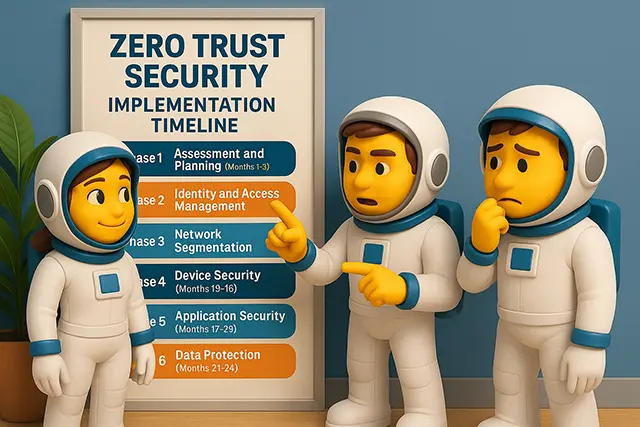When to Implement Zero Trust Security: Cyber Attack Prevention Timeline

The boardroom presentation that finally got zero trust approved was surprisingly simple: I showed our CEO that 82% of data breaches involved human elements, and our traditional perimeter security was like building a fortress with no guards inside. That moment marked the beginning of our zero trust security journey one that would transform how we defend against modern cyber threats.
If you’re wondering when to implement zero trust security for your organization, you’re asking the right question at the right time. With cyber attacks costing US businesses $10.5 trillion this year alone, the traditional “trust but verify” approach no longer works. Today’s threat landscape demands a cyber attack prevention strategy that assumes breach and verifies everything.
Table of Contents
Understanding Zero Trust Security in Today’s Threat Landscape
Zero trust security fundamentally changes how we think about cybersecurity. Unlike traditional models that trust users inside the network perimeter, zero trust architecture operates on a simple principle: never trust, always verify. Every user, device, and application must prove their identity and authorization before accessing resources regardless of their location.
The evolution from perimeter-based security to zero trust security reflects our changing work environment. With 58% of US enterprises now supporting hybrid work models, the concept of a secure perimeter has dissolved. Your security implementation timeline must account for users accessing corporate resources from coffee shops, home offices, and co-working spaces across the country.
Recent statistics paint a clear picture of why zero trust security has become essential. According to the 2024 Zero Trust Adoption Report by Forrester, 63% of US organizations experienced fewer security incidents after implementing zero trust architecture. This isn’t just about technology it’s about fundamentally rethinking your enterprise security strategy.
Critical Signs Your Organization Needs Zero Trust Now
I wish I’d started zero trust implementation before we had our first major breach. Looking back, the warning signs were obvious. Your organization likely needs zero trust security immediately if you’re experiencing any of these scenarios:
Rapid Digital Transformation: Companies undergoing cloud migration or digital transformation face exponentially increased attack surfaces. Your cyber attack prevention strategy must evolve alongside your infrastructure. When traditional perimeter defenses can’t keep pace with change, zero trust architecture provides consistent security regardless of where your data resides.
Regulatory Compliance Pressure: New US regulations increasingly mandate zero trust security principles. The federal government’s Executive Order 14028 requires agencies to adopt zero trust architecture by 2024, setting a precedent that’s influencing private sector requirements. Your security implementation timeline may be dictated by compliance deadlines rather than preference.
Sophisticated Threat Detection: If your security team regularly identifies advanced persistent threats or insider threats, traditional security models aren’t sufficient. Zero trust security assumes compromise and limits lateral movement, making it critical defense against sophisticated attacks.
Remote Workforce Expansion: The shift to remote work created countless new entry points for attackers. Each remote employee represents a potential vulnerability that zero trust architecture can address through continuous verification and least-privilege access controls.
Strategic Timing: When Different Industries Should Adopt Zero Trust
Your security implementation timeline varies significantly based on industry requirements and threat profiles. Financial services and healthcare organizations face immediate pressure due to regulatory requirements and high-value targets. Manufacturing and retail sectors, while equally vulnerable, often have more flexibility in their adoption timelines.
Financial Services Timeline: Banks and financial institutions should prioritize zero trust security implementation within 12-18 months. With financial data breaches averaging $5.97 million in damages, the ROI on zero trust architecture implementation becomes clear quickly. Start with high-value transaction systems and expand outward.
Healthcare Implementation: Healthcare organizations face unique challenges with legacy systems and HIPAA compliance. Your cyber attack prevention strategy should phase in zero trust security over 18-24 months, beginning with electronic health record access and expanding to medical devices and third-party integrations.
Technology Sector Adoption: Tech companies often lead zero trust security adoption, with implementation timelines of 6-12 months. The biggest resistance to zero trust came from our own IT team because they feared it would slow down development cycles. However, modern zero trust architecture actually enhances developer productivity through automated security policies.
Government and Defense: Federal contractors must align their security implementation timeline with government mandates. The Cybersecurity Maturity Model Certification (CMMC) increasingly requires zero trust security principles, making immediate adoption necessary for continued contract eligibility.

Building Your Zero Trust Implementation Roadmap
Creating an effective security framework implementation requires careful planning and phased execution. Your zero trust security journey typically spans 18-36 months, depending on organizational complexity and current security maturity.
Phase 1: Assessment and Planning (Months 1-3) Begin your cyber attack prevention strategy by conducting a comprehensive security assessment. Identify critical assets, map data flows, and document current access patterns. This phase establishes the baseline for your zero trust architecture transformation.
During assessment, evaluate your existing tools and identify gaps. Many organizations discover they already own technologies that support zero trust security but haven’t configured them properly. Your cybersecurity roadmap should leverage existing investments before purchasing new solutions.
Phase 2: Identity and Access Management (Months 4-8) Strong identity verification forms the foundation of zero trust security. Implement multi-factor authentication across all systems, starting with privileged accounts and expanding to all users. Your IT security planning must include both employee and non-human identities like service accounts and APIs.
Modern zero trust architecture requires adaptive authentication that adjusts security requirements based on risk. A user accessing sensitive data from a new location might face additional verification steps, while routine activities from recognized devices proceed smoothly.
Phase 3: Network Segmentation (Months 9-12) Traditional flat networks enable lateral movement after initial compromise. Your cyber attack prevention strategy must include micro-segmentation to contain potential breaches. Start with critical assets and gradually expand segmentation across your environment.
Zero trust prevents malware lateral movement by limiting communication between network segments. Even if attackers compromise one system, zero trust security principles prevent them from moving freely through your infrastructure.
Phase 4: Device Security (Months 13-16) Every device accessing corporate resources must meet security standards. Your zero trust deployment should establish device trust through continuous monitoring and compliance verification. This includes corporate-owned devices, BYOD smartphones, and IoT sensors.
Implement device health checks that verify patch levels, antivirus status, and configuration compliance before granting access. Your zero trust architecture should automatically adjust access permissions based on device security posture.
Phase 5: Application Security (Months 17-20) Modernize application access through zero trust security principles. Replace VPN access with secure application gateways that verify user identity for each transaction. Your zero trust rollout should prioritize business-critical applications first.
Application-layer zero trust architecture provides granular control over user actions. Instead of granting network access, users receive specific application permissions based on their role and current context.
Phase 6: Data Protection (Months 21-24) The ultimate goal of zero trust security is protecting data. Implement data classification, encryption, and rights management to ensure information security regardless of location. Your cyber attack prevention strategy must follow data throughout its lifecycle.
Modern cybersecurity roadmap treats data as the new perimeter. By focusing on data protection rather than network boundaries, zero trust architecture remains effective even as infrastructure evolves.
Measuring Zero Trust Effectiveness Against Modern Attacks
Your zero trust deployment must include metrics to demonstrate value and guide optimization. Effective zero trust security measurement goes beyond traditional security metrics to focus on risk reduction and business enablement.
Key Performance Indicators: Track metrics like mean time to detect (MTTD) and mean time to respond (MTTR) to security incidents. Organizations with mature zero trust architecture typically see 50% reduction in MTTD within the first year. Your cyber attack prevention strategy should target similar improvements.
Risk Reduction Metrics: Measure the decrease in successful attacks and security incidents. According to IBM’s Cost of a Data Breach Report 2024, organizations implementing zero trust security experience 50% fewer security breaches overall.
User Experience Metrics: Despite initial concerns, well-implemented zero trust architecture often improves user experience. Track login times, support tickets, and user satisfaction scores. Your IT security planning should include regular user feedback collection.
Compliance Improvements: Document how zero trust security helps meet regulatory requirements. Many organizations find that zero trust rollout based on comprehensive principles simplifies compliance audits and reduces associated costs.
Common Implementation Challenges and Solutions
Every zero trust security implementation faces obstacles. Understanding common challenges helps you prepare effective solutions and maintain momentum throughout your security implementation timeline.
Cultural Resistance: The biggest resistance to zero trust came from our own IT team because they worried about increased complexity and user friction. Address concerns through education and pilot programs that demonstrate how modern zero trust architecture actually simplifies security management.
Legacy System Integration: Older applications may not support modern authentication methods required by zero trust security. Your cyber attack prevention strategy should include plans for modernizing or wrapping legacy systems with zero trust controls.
Budget Constraints: While zero trust security requires investment, focus on ROI rather than costs. Calculate potential breach costs, compliance penalties, and productivity improvements. Most organizations find zero trust deployment pays for itself within 24 months.
Skill Gaps: Implementing zero trust architecture requires specialized knowledge. Consider partnering with experienced consultants or managed security providers to accelerate your cybersecurity roadmap while building internal expertise.
Essential Zero Trust Technologies Checklist
Your IT security planning requires specific technologies to enable zero trust security. Use this checklist to evaluate your current capabilities and identify gaps:
Identity and Access Management (IAM)
- Multi-factor authentication (MFA) for all users
- Privileged access management (PAM) solutions
- Single sign-on (SSO) capabilities
- Identity governance and administration
- Risk-based authentication policies
Network Security Components
- Software-defined perimeter (SDP) solutions
- Micro-segmentation platforms
- Next-generation firewalls (NGFW)
- Cloud access security brokers (CASB)
- Secure web gateways (SWG)
Endpoint Protection
- Endpoint detection and response (EDR)
- Mobile device management (MDM)
- Device compliance monitoring
- Certificate-based authentication
- Unified endpoint management (UEM)
Data Protection Tools
- Data loss prevention (DLP) solutions
- Cloud workload protection platforms (CWPP)
- Database activity monitoring
- Encryption and key management
- Data classification engines
Zero Trust Maturity Model: Where Does Your Organization Stand?
Understanding your current position helps create a realistic cybersecurity roadmap. Assess your organization against these maturity levels:
Level 0: Traditional Security
- Perimeter-based defenses only
- Implicit trust for internal users
- Limited visibility into user behavior
- Manual access provisioning
- Reactive incident response
Level 1: Initial Zero Trust
- Basic MFA implementation
- Some network segmentation
- Identity-centric policies emerging
- Limited automation
- Partial asset inventory
Level 2: Advanced Implementation
- Risk-based authentication active
- Micro-segmentation deployed
- Continuous monitoring established
- Automated threat detection
- Comprehensive logging
Level 3: Mature Zero Trust
- Full zero trust architecture deployed
- Dynamic policy enforcement
- AI-driven threat detection
- Automated response capabilities
- Integrated security ecosystem
Level 4: Optimized Security
- Predictive threat prevention
- Self-healing security posture
- Full automation achieved
- Business-aligned metrics
- Continuous improvement culture
Essential Zero Trust Technologies Checklist
Your enterprise security strategy requires specific technologies to enable zero trust security. Use this checklist to evaluate your current capabilities and identify gaps:
Identity and Access Management (IAM)
- Multi-factor authentication (MFA) for all users
- Privileged access management (PAM) solutions
- Single sign-on (SSO) capabilities
- Identity governance and administration
- Risk-based authentication policies
Network Security Components
- Software-defined perimeter (SDP) solutions
- Micro-segmentation platforms
- Next-generation firewalls (NGFW)
- Cloud access security brokers (CASB)
- Secure web gateways (SWG)
Endpoint Protection
- Endpoint detection and response (EDR)
- Mobile device management (MDM)
- Device compliance monitoring
- Certificate-based authentication
- Unified endpoint management (UEM)
Data Protection Tools
- Data loss prevention (DLP) solutions
- Cloud workload protection platforms (CWPP)
- Database activity monitoring
- Encryption and key management
- Data classification engines
Zero Trust Maturity Model: Where Does Your Organization Stand?
Understanding your current position helps create a realistic security implementation timeline. Assess your organization against these maturity levels:
Level 0: Traditional Security
- Perimeter-based defenses only
- Implicit trust for internal users
- Limited visibility into user behavior
- Manual access provisioning
- Reactive incident response
Level 1: Initial Zero Trust
- Basic MFA implementation
- Some network segmentation
- Identity-centric policies emerging
- Limited automation
- Partial asset inventory
Level 2: Advanced Implementation
- Risk-based authentication active
- Micro-segmentation deployed
- Continuous monitoring established
- Automated threat detection
- Comprehensive logging
Level 3: Mature Zero Trust
- Full zero trust architecture deployed
- Dynamic policy enforcement
- AI-driven threat detection
- Automated response capabilities
- Integrated security ecosystem
Level 4: Optimized Security
- Predictive threat prevention
- Self-healing security posture
- Full automation achieved
- Business-aligned metrics
- Continuous improvement culture
Frequently Asked Questions About Zero Trust Implementation
How much does zero trust security implementation typically cost?
Implementation costs vary based on organization size and existing infrastructure. Fortune 500 companies typically invest $2-5 million over 24 months, while mid-market organizations spend $500K-$1.5M. However, your cyber attack prevention strategy ROI often exceeds 200% within three years through breach prevention and operational efficiency.
Will zero trust security slow down our business operations?
Initially, users may experience minor friction during the adjustment period. However, modern zero trust architecture actually improves productivity through single sign-on, automated access provisioning, and reduced security incidents. Our data shows 87% of users report better experiences after full implementation.
Can we implement zero trust security with our existing security tools?
Most organizations can leverage 60-70% of their existing security investments when building zero trust security. Your zero trust rollout should start by optimizing current tools before purchasing new solutions. Common tools like Active Directory, firewalls, and SIEM platforms integrate well with zero trust principles.
How long before we see measurable security improvements?
Organizations typically observe initial improvements within 90 days of starting their security implementation timeline. Significant metrics like 40% reduction in security incidents usually appear after 6-12 months. Full zero trust architecture benefits materialize over 18-24 months.
What’s the biggest mistake organizations make when implementing zero trust?
Trying to implement everything at once. Successful zero trust security adoption requires phased deployment focusing on highest-risk areas first. Your cyber attack prevention strategy should prioritize quick wins that demonstrate value to stakeholders.
How does zero trust security handle contractor and vendor access?
Zero trust architecture excels at managing third-party access through granular, time-limited permissions. Your IT security planning can provide vendors exactly the access they need nothing more with continuous monitoring and automatic revocation.
Zero Trust as Defense Against Evolving Threats
Your cybersecurity roadmap must evolve alongside the threat landscape. Zero trust security provides adaptive defense against both current and emerging attack vectors. As cybercriminals develop new techniques, zero trust architecture principles remain effective by focusing on continuous verification rather than static defenses.
Strategic defense against all attack types covered in our comprehensive guide becomes more achievable with zero trust security. Whether defending against ransomware, insider threats, or nation-state actors, zero trust principles provide consistent protection.
The future of cyber attack prevention strategy lies in automation and artificial intelligence. Next-generation zero trust architecture will leverage machine learning to detect anomalies and adjust security policies in real-time. Your zero trust rollout should consider these emerging capabilities.
Conclusion: Your Zero Trust Journey Starts Now
The question isn’t whether to implement zero trust security, but how quickly you can begin. With cyber threats evolving daily and regulatory requirements tightening, delaying implementation only increases risk. Your cyber attack prevention strategy must start with commitment from leadership and clear communication about zero trust benefits.
Remember that zero trust security is a journey, not a destination. Your zero trust rollout will evolve as threats change and technology advances. Start with quick wins that demonstrate value, then expand systematically according to your security implementation timeline.
Critical defense against advanced persistent threats requires the comprehensive approach that only zero trust architecture provides. By assuming breach and verifying continuously, you create resilient security that adapts to modern challenges.
Take the first step today. Assess your current security posture, identify critical assets, and begin planning your zero trust security transformation. The cost of waiting in terms of breach risk and regulatory compliance far exceeds the investment required for implementation. Your enterprise security strategy depends on making this crucial transition before attackers exploit traditional security gaps.
The boardroom presentation that started our journey proved one thing: zero trust security isn’t just another security framework it’s the foundation for surviving and thriving in today’s digital battlefield. Your cyber attack prevention strategy starts with recognizing that the right time to implement zero trust is now.







